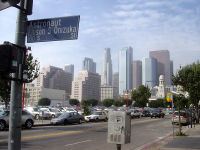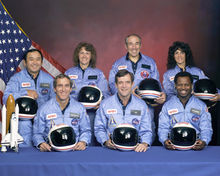Ellison Onizuka
| Ellison Shoji Onizuka | |
|---|---|
.jpg) |
|
| NASA Astronaut | |
| Nationality | American |
| Status | Killed during mission |
| Other occupation | Research Engineer |
| Rank | Lieutenant Colonel, USAF |
| Time in space | 3d 01h 33m |
| Selection | 1978 NASA Group |
| Missions | STS-51-C, STS-51-L |
| Mission insignia | |
Ellison Shoji Onizuka (Japanese: 鬼塚承次 June 24, 1946 - January 28, 1986) was a Japanese American astronaut from Kealakekua, Kona, Hawaii who successfully flew into space with the Space Shuttle Discovery on STS-51-C, before losing his life to the destruction of the Space Shuttle Challenger, where he was serving as Mission Specialist for mission STS-51-L. He was the first Asian American to reach space.
Contents |
Early life
Ellison Onizuka was the oldest son and second youngest child of the late Masamitsu and Mitsue Onizuka. He had two older sisters, Shirley and Norma, and a younger brother, Claude. Claude became the family spokesman when Ellison attained fame as an astronaut and continued after the Challenger accident. Growing up, Ellison was an active participant in 4-H and the Boy Scouts, where he reached the level of Eagle Scout.[1]
He graduated from Konawaena High School in Kealakekua in 1964. He received a Bachelor's degree in aerospace engineering in June 1969, and a Master's in that field in December of the same year, from the University of Colorado at Boulder. He participated in Air Force ROTC during his time there and is an alumnus of Triangle Fraternity.
Onizuka married Lorna Leiko Yoshida on June 7, 1969,[2] while completing his studies at the University of Colorado. They had two daughters, Janelle Onizuka-Gillilan (b. 1969) and Darien Lei Shizue Onizuka-Morgan (b. 1975).
Air Force career
On January 15, 1970, Onizuka entered active duty with the United States Air Force,[3] where he served as a flight test engineer and as a test pilot. At the Sacramento Air Logistics Center at McClellan Air Force Base. He worked in test flight programs and systems security engineering for the F-84, F-100, F-105, F-111, EC-121T, T-33, T-39, T-28, and A-1.
From August 1974 to July 1975, Onizuka attended the U.S. Air Force Test Pilot School. In July 1975, he was assigned to the Test Flight Center at Edwards Air Force Base in California. He became a squadron test flight engineer at the Test Pilot School, and later worked as a manager for engineering support in the training resources division. His duties there were based on the instruction of courses and the management of the airship fleet (A-7, A-37, T-38, F-4, T-33, and NKC-135) being used for the Test Pilot School and Test Flight Center. Onizuka managed to register more than 1,700 flight hours.
NASA career
Onizuka was selected for the astronaut program in January 1978, and completed one year of evaluation and training in August 1979. Later, he worked in the experimentation team, Orbiter test team, and launch support crew at the Kennedy Space Center for the STS-1 and STS-2. At NASA, he worked on the Shuttle Avionics Integration Laboratory (SAIL) test and revision software team. He also collaborated on other technical projects, for instance, as astronaut crew team coordinator.
His first space mission took place on January 24, 1985, with the Kennedy Space Center launch of mission STS 51-C on Space Shuttle Discovery, the first space shuttle mission for the Department of Defense. Onizuka was accompanied by the commander Ken Mattingly, pilot Loren Shriver, fellow mission specialist James Buchli, and payload specialist Gary E. Payton. During the mission, Onizuka was responsible for the activities of the primary payloads, which included the unfolding of the Inertial Upper Stage (IUS) surface. After 48 orbits around the Earth, Discovery landed at the Kennedy Space Center on January 27, 1985. Onizuka had completed a total of 74 hours in space.
Onizuka was assigned to the mission STS 51-L on the Space Shuttle Challenger that took off from Kennedy Space Center at 11:38:00 EST (16:38:00 UTC) on January 28, 1986. The other Challenger crew members were commander Dick Scobee, pilot Michael J. Smith, mission specialists Ronald McNair, Judith Resnik, and payload specialists Gregory Jarvis and Christa McAuliffe. Challenger was destroyed when a leaking solid rocket booster ruptured of the fuel tank at 73 seconds after launch. All seven crew members were killed. NASA had estimated that the probability of a catastrophic accident during launch, the most perilous portion of space flight, was 1 in 438.

Ellison was buried at the National Memorial Cemetery of the Pacific in Honolulu, Hawaii.[3]
At the time of his death, Onizuka held the rank of Lieutenant Colonel. Posthumously, Onizuka was promoted to the rank of Colonel.
Memberships and distinctions
Onizuka belonged to the following organizations: Society of Flight Test Engineers, the Air Force Association, the American Institute of Aeronautics and Astronautics, Tau Beta Pi, Sigma Tau, Arnold Air Society, and Triangle Fraternity.
Among his distinctions are the Air Force Commendation Medal, Air Force Meritorious Service Medal, Air Force Outstanding Unit Award, Air Force Organizational Excellence Award, and National Defense Service Medal. He was posthumously awarded the Purple Heart medal and the Congressional Space Medal of Honor.
Legacy

Onizuka Air Force Station in Sunnyvale, California, Onizuka Village family housing on Hickam Air Force Base and the Astronaut Ellison S. Onizuka Space Center at Kona International Airport in the Kona district of Hawaiʻi island where he was born and raised, are dedicated to him.[4]
Two astronomical features were also named after him: an asteroid discovered by Edward L. G. Bowell on February 8, 1984, 3355 Onizuka and a 29-km-diameter crater on the Moon, Onizuka.
Little Tokyo in Los Angeles, California also has a street named after him, as does the street surrounding Whitcomb Elementary in Clear Lake City, Houston, Texas, where his daughters attended school at the time of the Challenger disaster. The school also named its library the Onizuka Memorial Library. In addition, the Onizuka Street in Little Tokyo has a scale replica of the Space Shuttle Challenger as a memorial.[5]
The Onizuka Center for International Astronomy, named in his honor, is the mid-level support and visitor complex for the Mauna Kea Observatories in Hawai'i. The complex includes a Visitor Information Station as well as dining, lodging, office and maintenance facilities for observatory staff and astronomers..[6] A plaque of Onizuka's face is mounted on a boulder by the entrance to the Visitor Information Station.
Triangle Fraternity has the Ellison Onizuka Young Alumnus Award in tribute to him.
The Engineering Center at the University of Colorado at Boulder has a conference room named after him.
Page 28 (Page X of additional page inserts) of every new U.S. passport contains this quote:
"Every generation has the obligation to free men's minds for a look at new worlds... to look out from a higher plateau than the last generation." - Ellison S. Onizuka
The Hawai'i Space Grant Consortium holds an annual Astronaut Ellison Onizuka Science Day[7] at the University of Hawai'i-Hilo for students in grades 4-12, parents and teachers.
In movies/TV
- Onizuka was portrayed by Keone Young in the 1990 TV movie Challenger.
- In Star Trek: The Next Generation, a shuttlecraft carried aboard the starship Enterprise bears his name, as seen in the three episodes "The Ensigns of Command", "The Mind's Eye" and "The Outcast."
References
- ↑ Townley, Alvin. Legacy of Honor: The Values and Influence of America's Eagle Scouts. New York: St. Martin's Press. pp. 79. ISBN 0-312-36653-1. http://www.thomasdunnebooks.com/TD_TitleDetail.aspx?ISBN=0312366531. Retrieved 2006-12-29.
- ↑ "iCRIS Record Search". Boulder County Recording Division. http://www.bouldercounty.org/clerk/recording/search/icris.htm. Retrieved 2008-07-22.
- ↑ 3.0 3.1 "National Cemetery Administration. U.S. Veterans Gravesites, ca.1775-2006". Provo, UT, USA: The Generations Network, Inc.. 2006. http://www.ancestry.com/search/db.aspx?dbid=8750&enc=1.
- ↑ "Astronaut Ellison S Onizuka Space Center". 2008. http://www.moonchasers.com/onizuka.html. Retrieved August 26, 2010.
- ↑ Astronaut Ellison S. Onizuka Memorial in Little Tokyo
- ↑ "Visitor Information Station". Onizuka Center for International Astronomy official web site. University of Hawaii Institutute for Astronomy. http://www.ifa.hawaii.edu/info/vis/. Retrieved August 26, 2010.
- ↑ "Astronaut Ellison Onizuka Science Day". Hawai'i Space Grand Consortium. 2009. http://www.spacegrant.hawaii.edu/OnizukaDay/.
- This article draws heavily on the corresponding article in the Spanish-language Wikipedia, which was accessed in the version of July 8, 2005.
External links
- Official NASA Bio
- Challenger Center bio
- Astronaut Memorial Foundation website
- Ellison Onizuka at Find a Grave
|
||||||||
|
|||||||||||||||
|
||||||||||||||||

